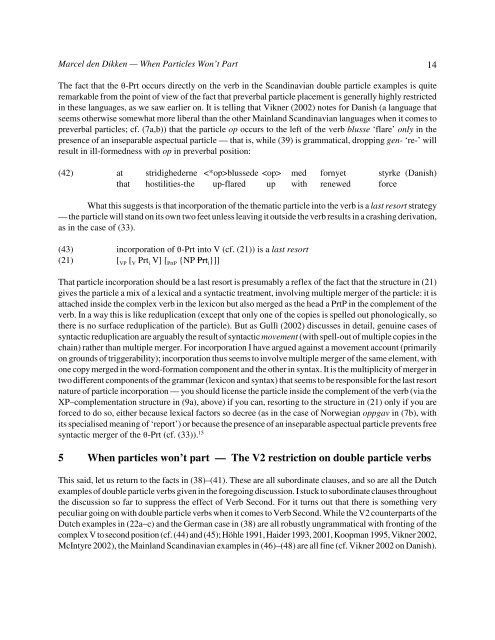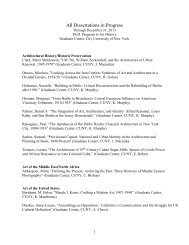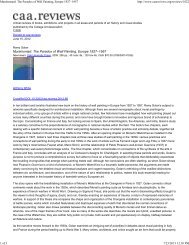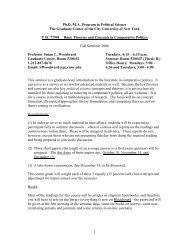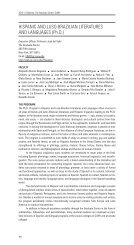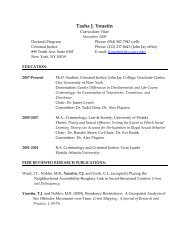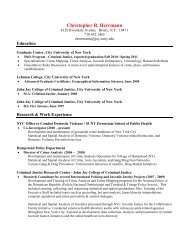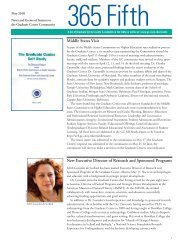When Particles Won't Part - CUNY Graduate Center
When Particles Won't Part - CUNY Graduate Center
When Particles Won't Part - CUNY Graduate Center
You also want an ePaper? Increase the reach of your titles
YUMPU automatically turns print PDFs into web optimized ePapers that Google loves.
Marcel den Dikken — <strong>When</strong> <strong><strong>Part</strong>icles</strong> Won’t <strong>Part</strong><br />
The fact that the 2-Prt occurs directly on the verb in the Scandinavian double particle examples is quite<br />
remarkable from the point of view of the fact that preverbal particle placement is generally highly restricted<br />
in these languages, as we saw earlier on. It is telling that Vikner (2002) notes for Danish (a language that<br />
seems otherwise somewhat more liberal than the other Mainland Scandinavian languages when it comes to<br />
preverbal particles; cf. (7a,b)) that the particle op occurs to the left of the verb blusse ‘flare’ only in the<br />
presence of an inseparable aspectual particle — that is, while (39) is grammatical, dropping gen- ‘re-’ will<br />
result in ill-formedness with op in preverbal position:<br />
(42) at stridighederne blussede med fornyet styrke (Danish)<br />
that hostilities-the up-flared up with renewed force<br />
What this suggests is that incorporation of the thematic particle into the verb is a last resort strategy<br />
— the particle will stand on its own two feet unless leaving it outside the verb results in a crashing derivation,<br />
as in the case of (33).<br />
(43) incorporation of 2-Prt into V (cf. (21)) is a last resort<br />
(21) [ VP [ V Prt i V] [ PrtP {NP Prt i}]]<br />
That particle incorporation should be a last resort is presumably a reflex of the fact that the structure in (21)<br />
gives the particle a mix of a lexical and a syntactic treatment, involving multiple merger of the particle: it is<br />
attached inside the complex verb in the lexicon but also merged as the head a PrtP in the complement of the<br />
verb. In a way this is like reduplication (except that only one of the copies is spelled out phonologically, so<br />
there is no surface reduplication of the particle). But as Gullì (2002) discusses in detail, genuine cases of<br />
syntactic reduplication are arguably the result of syntactic movement (with spell-out of multiple copies in the<br />
chain) rather than multiple merger. For incorporation I have argued against a movement account (primarily<br />
on grounds of triggerability); incorporation thus seems to involve multiple merger of the same element, with<br />
one copy merged in the word-formation component and the other in syntax. It is the multiplicity of merger in<br />
two different components of the grammar (lexicon and syntax) that seems to be responsible for the last resort<br />
nature of particle incorporation — you should license the particle inside the complement of the verb (via the<br />
XP–complementation structure in (9a), above) if you can, resorting to the structure in (21) only if you are<br />
forced to do so, either because lexical factors so decree (as in the case of Norwegian oppgav in (7b), with<br />
its specialised meaning of ‘report’ ) or because the presence of an inseparable aspectual particle prevents free<br />
syntactic merger of the 2-Prt (cf. (33)). 15<br />
5 <strong>When</strong> particles won’t part — The V2 restriction on double particle verbs<br />
This said, let us return to the facts in (38)–(41). These are all subordinate clauses, and so are all the Dutch<br />
examples of double particle verbs given in the foregoing discussion. I stuck to subordinate clauses throughout<br />
the discussion so far to suppress the effect of Verb Second. For it turns out that there is something very<br />
peculiar going on with double particle verbs when it comes to Verb Second. While the V2 counterparts of the<br />
Dutch examples in (22a–c) and the German case in (38) are all robustly ungrammatical with fronting of the<br />
complex V to second position (cf. (44) and (45); Höhle 1991, Haider 1993, 2001, Koopman 1995, Vikner 2002,<br />
McIntyre 2002), the Mainland Scandinavian examples in (46)–(48) are all fine (cf. Vikner 2002 on Danish).<br />
14


